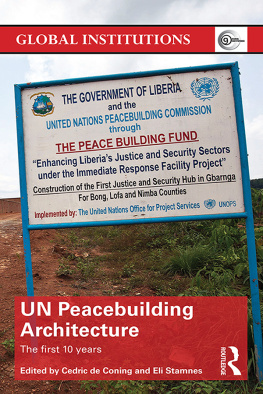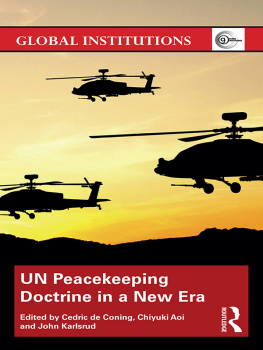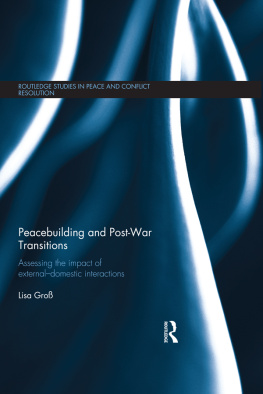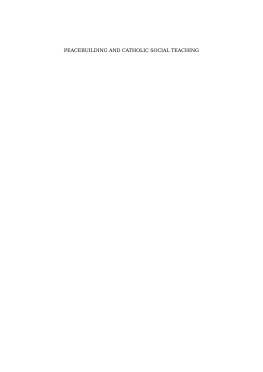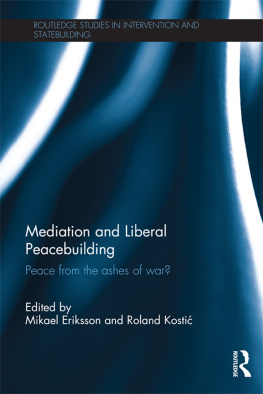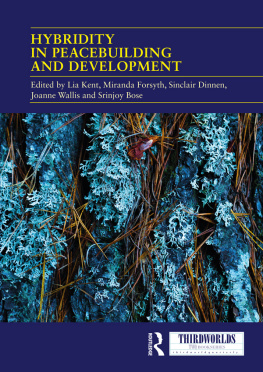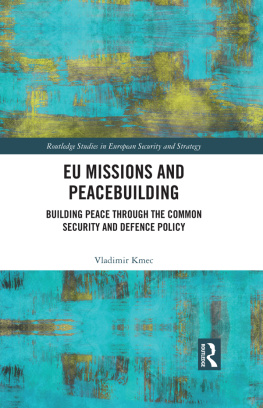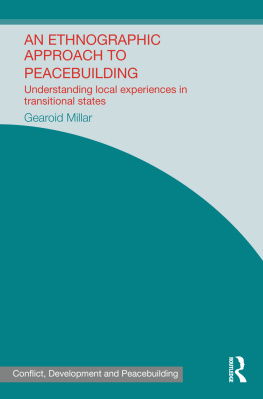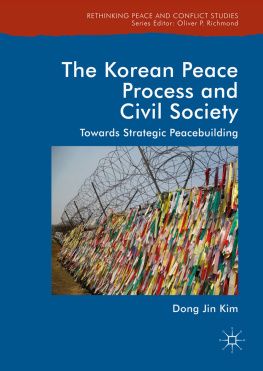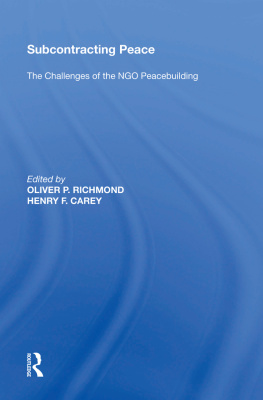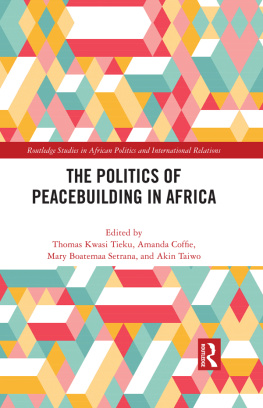This is a very important and timely book, providing an in-depth assessment of the first ten years of the United Nations Peacebuilding Architecture. It provides an historical overview of its creation and development over time, an appraisal of its performance and recommendations for improvements. I strongly recommend this book to anyone interested in peacebuilding, not in the least the Member States who are making decisions on the role of peacebuilding in the United Nations.
Oscar Fernndez-Taranco, United Nations Assistant
Secretary-General for Peacebuilding Support
The rigorous and rich research contained in this volume is invaluable for efforts to move the Peacebuilding agenda forward at the UN and, ultimately, for strengthening our collective ability to prevent and respond to conflicts.
Ambassador Olof Skoog, Swedish Permanent Representative
to the United Nations in New York and Chairperson
of the UN Peacebuilding Commission (2015)
Riveting and essential reading on how the UN translates decades of grassroots peacebuilding efforts into a global project that is internally led and externally supported with a brew of good intentions, confused expectations, and faulty assumptions.
Lisa Schirch, Research Director, Toda Institute for Global
Peace and Policy Research and Research Professor,
Center for Justice and Peacebuilding,
Eastern Mennonite University, USA
UN Peacebuilding Architecture
Since its establishment, the UNs Peacebuilding Architecture (PBA) has been involved in peacebuilding processes in more than 20 countries. This edited volume takes stock of the overall impact of the PBA during its first decade in existence, and generates innovative recommendations for how the architecture can be modified and utilized to create more synergy and fusion between the UNs peace and development work.
The volume is based on commissioned research and independent evaluations, as well as informed opinions of several key decision-makers closely engaged in shaping the UNs peacebuilding agenda. It seeks to find a balance between identifying the reality and constraints of the UNs multilateral framework, while being bold in exploring innovative ways in which the UN can enhance the results of its peace and development work through the PBA.
The research and writing of each chapter is guided by four objectives:
to assess the overall impact of the PBA;
to generate innovative ideas for how the PBA can be made more effective post-2015;
to analyze the PBAs role at the nexus of the UNs peace and development work;
to consider what would be required for the PBA to increase and improve its impact in the future.
It will be of interest to diplomats, UN officials, the policy community, and scholars engaged in the debate following the 2015 review and the implementation of its recommendations, and will be an essential resource for UN and peacebuilding scholars.
Cedric de Coning is a Senior Research Fellow in the Peace and Conflict Research Group at the Norwegian Institute of International Affairs (NUPI) and a Peacebuilding Advisor with ACCORD. His research focus is on AU, EU and UN peacekeeping and peacebuilding policies and practices.
Eli Stamnes is a Senior Research Fellow in the Peace and Conflict Research Group at the Norwegian Institute of International Affairs (NUPI). Her research interests revolve around critical approaches to peace and security, peacebuilding, conflict pre-vention, gender and the Responsibility to Protect (R2P)
Global Institutions
Edited by Thomas G. Weiss
The CUNY Graduate Center, New York, USA and Rorden Wilkinson
University of Sussex, Brighton, UK
About the series
The Global Institutions Series provides cutting-edge books about many aspects of what we know as global governance. It emerges from our shared frustrations with the state of available knowledgeelectronic and print-wise, for research and teachingin the area. The series is designed as a resource for those interested in exploring issues of international organization and global governance. And since the first volumes appeared in 2005, we have taken significant strides toward filling conceptual gaps.
The series consists of three related streams distinguished by their blue, red, and green covers. The blue volumes, comprising the majority of the books in the series, provide user-friendly and short (usually no more than 50,000 words) but authoritative guides to major global and regional organizations, as well as key issues in the global governance of security, the environment, human rights, poverty, and humanitarian action among others. The books with red covers are designed to present original research and serve as extended and more specialized treatments of issues pertinent for advancing understanding about global governance. And the volumes with green coversthe most recent departure in the seriesare comprehensive and accessible accounts of the major theoretical approaches to global governance and international organization.
The books in each of the streams are written by experts in the field, ranging from the most senior and respected authors to first-rate scholars at the beginning of their careers. In combination, the three com-ponents of the seriesblue, red, and greenserve as key resources for faculty, students, and practitioners alike. The works in the blue and green streams have value as core and complementary readings in courses on, among other things, international organization, global governance, international law, international relations, and international political economy; the red volumes allow further reflection and investigation in these and related areas.
The books in the series also provide a segue to the foundation volume that offers the most comprehensive textbook treatment available dealing with all the major issues, approaches, institutions, and actors in contemporary global governanceour edited work International Organization and Global Governance (2014)a volume to which many of the authors in the series have contributed essays.
Understanding global governancepast, present, and futureis far from a finished journey. The books in this series nonetheless represent significant steps toward a better way of conceiving contemporary pro-blems and issues as well as, hopefully, doing something to improve world order. We value the feedback from our readers and their role in helping shape the on-going development of the series.
A complete list of titles appears at the end of this book. The most recent titles in the series are:
Displacement, Development, and Climate Change (2016)
by Nina Hall
UN Security Council Reform (2016)
by Peter Nadin
International Organizations and Military Affairs (2016)
by Hylke Dijkstra
The International Committee of the Red Cross (2nd edition, 2016)
by David P. Forsythe and Barbara Ann J. Rieffer-Flanagan
The Arctic Council (2016)
by Douglas C. Nord
Human Development and Global Institutions (2016)
by Richard Ponzio and Arunabha Ghosh
NGOs and Global Trade (2016)
by Erin Hannah

